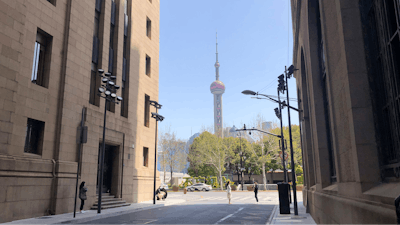
BEIJING (AP) — Chinese authorities sought to reassure companies and jittery investors on Tuesday as a two-phase lockdown of Shanghai’s 26 million people entered its second day, casting an unusual quiet over the normally bustling center of finance, manufacturing and trade.
The omicron outbreak in Shanghai is one of a series across the country that is testing the government’s ability to enforce a strict “zero-COVID” strategy without overly disrupting the economy and people’s daily lives.
Many shops were shuttered and pedestrians were sparse even in the half of the city that remained open. The lockdown is being conducted in two phases to limit the disruption, starting with the Pudong financial district and adjacent areas on the east side of the Huangpu River that divides Shanghai.
Zhang Meisha, taking a morning jog along the fabled Bund on the river’s west bank, said she hoped to enjoy more sunshine before the lockdown shifted to Puxi. Only an occasional tourist lingered on the promenade lined with century-old historic buildings.
“It’s so beautiful, but not many people can come here to enjoy and appreciate,” Zhang said of the red and yellow tulips along the Bund. “Such a pity! I hope the spring of Shanghai can wait for us.”
The shutdown has added to anxiety in financial markets over Russia’s war on Ukraine, the U.S. Federal Reserve’s effort to cool surging inflation by raising interest rates and other challenges facing the global economy.
Market reactions including Monday’s 7% drop in oil prices in London don’t reflect the “true reality of the situation,” but investors already were uneasy about China and the global economy, said Michael Every of Rabobank.
“We have a whole mountain of problems to worry about, and this is just one foothill among many,” he said. “If that’s all it is, a COVID lockdown, it’s not difficult to look in recent history books and see how it plays out. But this interfaces with a lot of other issues.”
Any interruption of activity at the port of Shanghai poses a greater threat to industry and trade. State media reported that the world’s biggest port was handling normal cargo volumes and that managers were ensuring that vessels “can call normally” at the port. General Motors Co. and Volkswagen AG said their Shanghai factories were operating normally.
The new omicron BA.2 subvariant is widely blamed for a surge of cases in China this month. By far, the hardest hit area has been Jilin province in the northeast.
Only two deaths have been reported, bringing the total since the start of the pandemic to 4,638, The relatively low death toll and case count has been touted by the ruling Communist Party as evidence of the wisdom of its zero-COVID approach.
Outside of mainland China, new cases have declined in Hong Kong following a recent wave that has led to more than 7,000 deaths. The semi-autonomous city of 7.4 million people recorded 7,596 new cases in the latest 24-hour period.
Shanghai recorded 4,477 new cases on Monday, all but 96 of them asymptomatic. Gymnasiums and exhibition centers have been converted into sprawling centers to isolate positive cases under the zero-COVID approach.
The measures confining the residents of Pudong to their homes, closing nonessential businesses and requiring mass testing are to be lifted Friday after four days. At that time, the Puxi area on the opposite side of the river will go under lockdown.
Shops in Puxi along the Nanjing Road pedestrian shopping street were mostly closed Tuesday, with few people out and about. Restaurants offered only takeaway service, and a long line formed outside a McDonalds of people waiting to pick up their orders.
Authorities are working to ensure food supplies after panic buying on Sunday and reports of shortages of meat and vegetables.
The Shanghai lockdown stands to become the largest of any city in China’s campaign against the virus, in which millions have been confined to their homes for weeks at a time in cities across much of the country.
Government workers in hazmat suits, joined by about 68,000 volunteers, are stationed at checkpoints around residential compounds that have been walled off with traffic dividers and improvised barriers.
Despite central government calls for a more targeted approach and some tweaking of the system, the decision to lock down Shanghai shows the continuing reliance on extreme measures.
Besides the two-phase approach, authorities have also given definite end dates for the lockdowns in Shanghai, unlike in other cities earlier.
Financial services firm Macquarie Group said the Shanghai lockdown indicates China will stick with its zero-COVID strategy at least until the ruling Communist Party holds its once-every-five-year congress this fall.
Authorities have promoted the need for stability in the runup to the event, when Xi Jinping is expected to be granted a third five-year term as party leader in a break with recent practice.
China boasts a vaccination rate of around 87% but the percentage is much lower among seniors, who are more vulnerable to the virus.
Macquarie Group said in a report that China should be able to contain the virus in the next few weeks, given the effectiveness of lockdowns.
“But COVID does pose substantial growth downside risk in the rest of this year, as lockdown is also very costly," the report said, adding that consumer spending and the housing market were set to take the biggest hits.
Wang Hui, who runs a shop near the Bund, said high rents and a lack of customers could cost him his business.
“I don’t know how much longer we can last,” Wang said.






















